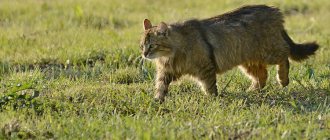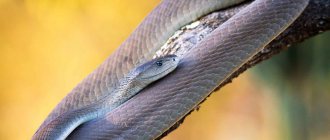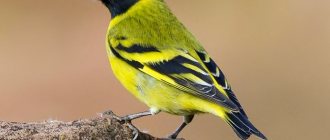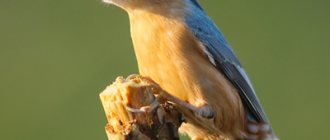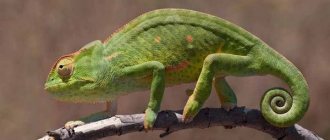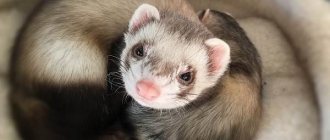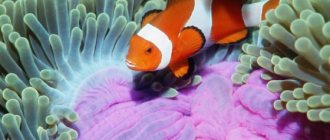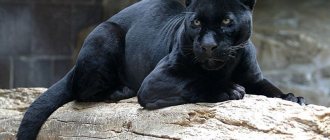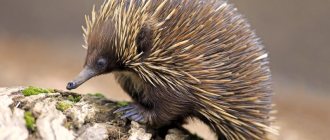Home » Other animals
Classification Species: Russian Muskrat
Family: Moles
Order: Shrews
Class: Mammals
Type: Chordata
Subphylum: Vertebrates
Dimensions: body length: 18-22 cm and tail about the same length; body weight: up to 500 g
Lifespan: 4 years in the wild, up to 5 years in captivity
The muskrat is one of the strangest and most mysterious species of animals, on the verge of extinction.
Modern photographs of this animal in nature may become the last if efforts are not made to preserve this amazing species.
Finding a high-quality photo of a muskrat, much less seeing it in its natural habitat, is becoming increasingly difficult.
This amazing and very strange animal is rapidly dying out. Whether our descendants will see it in nature is a big question.
Looking at the photo, it seems that the positive and eternal smile never leaves the face of this animal.
- 2 Characteristics
- 3 Appearance
- 4 Main features
- 5 Food
- 6 Reproduction
- 7 Relationships with a person
Habitat
The muskrat, also known as the khokhulya or simply the Russian muskrat, is an endemic species, that is, living in a narrow territory.
Mostly in Russia (the basins of the Ural, Don and Dnieper rivers, in the upper reaches of the Volga), but also in some parts of the former USSR - in Kazakhstan and Ukraine.
The animal, like otters and beavers , leads a semi-aquatic lifestyle, preferring closed bodies of water.
Important! There is another type of animal - the Pyrenean muskrat, common in Spain, Portugal and the South-West of France. It is about one and a half times smaller than the Russian muskrat and has a noticeably rounded tail.
This is what the Pyrenean cousin of the Russian waterfowl looks like
The first description of a strange mammal was made in the second half of the 18th century. Since 1986, the muskrat has been listed in the Red Book.
The population of the small mammal continues to decline. Presumably today the population of Russian Khokhuli is up to 35 thousand individuals.
The calculation is complicated by the fact that in some areas they stopped counting the number of animals.
The main cause of extinction is anthropogenic human activity. This led to:
- water pollution;
- deforestation and water withdrawal for agricultural irrigation;
- fishing with nets and some other factors.
Interesting! The muskrat is depicted on a silver 1 ruble coin from the “Red Book” series.
The muskrat is now endangered as a species.
Muskrat in the Red Book
Being a rare relict species, the muskrat is included in the Red Book of the Russian Federation. Every year the population of this small inhabitant of the planet is declining. The state is trying to do everything possible to preserve the animal and protect it from poachers.
Main causes of extinction
This deplorable situation regarding the animal population is associated primarily with the thoughtless deforestation of forests, pollution, drainage of rivers and lakes, the construction of reservoirs, and the establishment of pastures near water bodies.
The predominantly anthropogenic (artificially created) factor is the worst culprit in the decline in the number of Russian muskrats.
Current population situation
It is very difficult to determine the number of Russian desman in large areas. In recent years, counting has practically stopped; documents often contain different figures. By the beginning of the 90s, the number of individuals of waterfowl on the territory of the country decreased to 40 thousand animals, another 2 thousand were registered by scientists on Kazakh territory.
According to the expert service, today the number of this species in Russian open spaces is more than 34 thousand individuals. Colonies of animals are concentrated mainly in the Volga river basins - 20 thousand and Don rivers - 10 thousand mammals. Approximately 2 thousand animals live on the banks of the Dnieper River; a few settlements have been spotted along the banks of the Urals.
Parts of the Ob River became inhabited by animals thanks to forced settlement. Today, the largest population is located in the Kurgan region - 2,000 animals. Animals are rarely found in Tomsk and Novosibirsk reservoirs, since high floods constantly occur there, and security measures are also weakened.
What measures are taken to protect
The status of an endangered species does not stop poachers from illegal fishing. Fishing nets pose a great threat, where unfortunate animals die. The Red Book species is under the patronage of animal protection international and Russian organizations.
Individuals are being resettled into free areas for more comfortable living. Protected zones have been created, supported by existing programs for the speedy restoration of the population. Now the Russian Federation has 4 protected areas and 80 reserves for Russian muskrats.
Characteristic
The muskrat is a relict animal. That is, it belongs to species that have not changed over a long period of evolution.
The description of the appearance of a modern waterfowl is no different from its distant ancestors. Presumably, Khokhulya has existed on Earth for 30 million years and was previously settled throughout almost all of Europe.
That is, it is literally a contemporary of mammoths, which can precisely explain the strange and funny appearance of the animal: it seems to be not from this era. According to this characteristic, the muskrat is close to the echidna or the ancient lizard that has survived to this day.
Muskrats live in burrows with one exit that opens under water. The length of one hole reaches three meters and it is located above the water level.
There are usually several extensions inside. In winter, more than 10 animals can live in one burrow. In the summer they live in pairs, families, some alone.
This is a land mammal, but only formally: this baby spends half its life in water. Stealth and unnoticed movements are the main principles of life of this inhabitant of rivers and their banks
It’s funny that despite such “communal” winter living, each of the neighbors has their own temporary hole. All of them are connected by underwater passages 25-30 meters long.
In any case, with the onset of high water, the burrows are flooded with water, and the animals escape either in temporary burrows on non-flooded areas of the shore, or climb onto the branches of trees standing in the water.
Interesting! The muskrat is sometimes called the “blind submariner,” which perfectly describes the lifestyle of this animal. This is why it is so difficult to find a good photo of the Khokhuli: it constantly hides either underground or under water.
Lifestyle
The muskrat leads a semi-aquatic lifestyle. The most favorable habitats for muskrats are closed floodplain reservoirs (such as oxbow lakes) with a water surface area of 0.1–0.5 hectares and a depth of 1.3–5 m, with areas of low but dry steep banks with aquatic vegetation and the proximity of floodplain forest.
For most of the year, the animals live in burrows with one exit each. The exit opens underwater. The main part of the passage, located above the water level, runs almost horizontally for 2.5-3 meters and is equipped with 2-3 extensions (chambers or rings). During the flood period, the chambers are flooded, the animals leave them and then take refuge in half-flooded trees, in piles of sediment, or in shallow temporary burrows dug in non-flooded areas of the bedrock bank. At the bottom of the reservoir, between the entrances to two adjacent burrows, a trench is laid, cutting through the entire thickness of the silt to the sandy base.
In summer, muskrats live alone, in pairs or in families, and in winter, up to 12-13 animals of different sexes and ages can live in one hole. Each animal has temporarily visited burrows located at a distance of 25-30 meters from one another. The muskrat swims this distance along the connecting trench during the normal period of its stay under water - in 1 minute (although it can linger in the water column for up to 3-4 minutes).
In captivity, muskrats live up to 5 years, in the wild - up to 4.
Appearance
You can’t call this animal cute, but it’s quite cute. He is often called the funniest Russian animal.
Here are the main features of a small mammal that can safely be called a water mole:
- The nose is in the shape of a trunk.
- Vibrissae (antennae) are very long.
- The tail is massive, covered with horny scales and changes shape several times along its entire length - it either shrinks or thickens (the thickening contains scent glands).
- The muskrat moves on short legs, and the hind feet are noticeably larger and wider than the front ones.
- There are membranes between the toes right up to the claws that help the muskrat swim.
- The fur is thick and fluffy, reliably lubricated with fat.
The last point is especially important, because you have to swim in winter.
The nose, more like a trunk, plays a more significant role than small eyes that see practically nothing
Interesting facts about muskrat:
Previously, the muskrat was known as a valuable commercial species. Until the 17th century, its extraction was associated with a musky aroma. So, in Rus', dried muskrat tails were folded into linen. Later, musk began to be used in perfumery as a fixative for the scent of perfume. And then people paid attention to the practical fur of the animal; it was valued higher than beaver fur, and it was very popular. To obtain it, the animal was exterminated so actively that it was almost completely destroyed. And only after this the animal was protected by laws that prohibited its production. Until the mid-70s of the last century, it was possible to increase the population to 70,000 individuals. But lately it has been decreasing again. In Russia, 4 nature reserves and 80 sanctuaries for muskrats have been created.
Key Features
This inhabitant of rivers and coastal zones is extremely secretive. Despite the fact that he often lives near people, it is difficult to see him with his own eyes.
It is generally impossible to compile a description from outside observations. The river hunter emerges from under the water only to take a breath and dive again.
At this moment, you can track its movement through the air bubbles that appear every now and then on the water surface.
In the photo, the muskrat looks like a blind animal. This is practically true, because her eyes are a rudiment, and their size is extremely small.
Despite almost complete blindness, the Ukrainian is well oriented in space thanks to its excellent sense of touch and smell, and it is also an excellent hunter.
True, it is only good under water, because on land, alas, the long-tailed swimming mole looks extremely clumsy and almost helpless.
Therefore, it leaves the water only when absolutely necessary. Moreover, there are too many predators above water and on land, so an underwater lifestyle is also the key to its long duration.
The animal's fur is interesting. Its structure is different from anything that modern mammals have. You can’t see it in the photo, but the hairs widen towards the end, while on the roots, on the contrary, they are narrowed.
This fur does not allow air to pass through at all. For this reason, parasites often settle in it - muskrat beetles, which use the oxygen available in the fur to live under water.
It was because of the fur that the species was once brought to the brink of extinction - it was valued even more than the fur of the Arctic fox .
In fact, the fur only seems wet from the outside - it’s just a thin film of water, underneath which it’s dry and warm
Unlike many other mammals, this underwater inhabitant does not hibernate in winter: activity remains at the same level.
Moreover, in the winter months, work is literally in full swing to raise a new generation of cubs, which. By the way, it happens again in the summer.
Interesting! The name “khokhulya” comes from the obsolete verb “khukhat”, that is, “to stink”. This is due to the musk odor released by the muskrat's scaly tail.
Description
Desmana moschata (lat. Desmana moschata) belongs to the mole family, from the order of insectivores. This is an amphibious animal that lives on land, but searches for prey under water.
The size of the khokhulya does not exceed 18-22 cm, weighs about 500 grams, and has a protruding flexible muzzle with a trunk-shaped nose. Tiny eyes, ears and nostrils close underwater. The Russian desman has short, five-fingered limbs with membranous septa. The hind legs are larger than the front ones. The claws are long, sharp and curved.
The animal's fur is unique. It is very thick, soft, durable and coated with an oily liquid to increase slip. The structure of the pile is surprising - thin at the root and widened towards the end. The color of the back is dark gray, the belly is light or silver gray.
The muskrat's tail is interesting - up to 20 cm long, it has a pear-shaped seal at the base, in which glands are located that secrete a specific odor. Next comes a kind of ring, and the continuation of the tail is flat, covered with scales, and in the middle there are also hard fibers.
Animals are practically blind, so they navigate in space thanks to their developed sense of smell and touch. Sensitive hairs grow on the body, and long whiskers grow near the nose. The Russian muskrat has 44 teeth.
Nutrition
The muskrat eats a lot - up to a volume equal to its own weight per day! The animal is an excellent hunter, despite its natural blindness.
Long whiskers are the main source of signals coming from outside about the outside world and about the movement of potential prey as well.
The species is positioned as an insectivore, but in practice the diet is much richer. In summer, the khokhulya eats leeches, river insects, and gastropods.
In winter, he manages to catch small fish and partially switches to a plant-based diet.
To find food, this furry hunter carefully examines the bottom of the reservoir with his amazing nose and digs up the mud with his paws. The prey is brought to a hole or a safe place, where the hunt gives way to a meal.
A good catch is the river mussel. But it's just a light snack
The “water moles” themselves often become victims of larger predators: ferrets , foxes and stoats, as well as birds like the kite, golden eagle or marsh harrier.
The list of dangerous enemies of the small waterfowl is long. However, the biggest danger is not in predators, but in animals such as muskrat or mink.
They displace muskrats from their natural habitats.
What does the Russian muskrat eat?
Possessing great mobility and a high metabolism, the Russian desman needs a large amount of high-calorie food. This activity is maintained almost throughout the year. The basis of the diet of the Russian muskrat is animal food, although the animal does not disdain aquatic vegetation.
Most often, muskrats appear on the menu:
- aquatic insects;
- insect larvae;
- small crustaceans;
- shellfish;
- leeches and other worms.
In addition, the animal happily feasts on small fish and frogs if it manages to catch them. Periodically supplements its diet with stalks of cattails, reeds, and egg capsules.
The khokhulya hunts exclusively in water, and eats its prey on land. During the hunt, the animal orients itself with the help of whiskers. Having discovered prey, it grabs it with its teeth and carries it to a hole or secluded place on the shore, where it feasts on it. In addition to soft insect larvae, the muskrat also copes well with shellfish thanks to its strong and sharp front teeth. Since the muskrat’s “dining room” is located in the same place, it is not difficult to find the habitat of this secretive animal from the remains of food.
An important role in the hunting process of the Russian desman is played by the grooves on the bottom of the reservoir. Constantly moving along them, the animal ensures periodic circulation of water and enriches it with air. Aquatic insects and their larvae more actively swim into oxygen-rich water, which the khokhulya hunts.
Reproduction
The mating season for muskrats begins during the spring flood.
Sexually mature individuals (about 11 months old) create pairs just at the time when they leave the flooded burrows.
These days, the silence on the river banks is broken by the loud chirping of males and the melodic sounds made by females. Tough battles between males are common.
Couples are formed at the time of a general disaster - the flooding of familiar homes
Pregnancy lasts about 50 days. One female gives birth to no more than 5 cubs. Sometimes there is only one.
The babies are hairless, in addition they are blind and completely helpless. They need protection, for which the mother makes a nest from bottom plants.
The cubs weigh about 3 g and grow in conditions of very low temperature and incredible humidity. Muskrats breed in May-June and November-December.
Males remain nearby with the brood. After only 4 months, babies become adults and completely independent.
Interesting! In case of danger, the female can transport the cubs to another hole on her own back.
Enemies
The movement of these animals on land is very difficult, and therefore this animal has quite a lot of enemies on land. These include animals such as foxes, otters, wild cats, ferrets and in some cases kites.
These animals have to leave the water surface during the spring flood. The time of their reproduction also falls during this same period.
What does a muskrat look like?
The animal looks quite unusual. The rolled body, reaching a length of 20 cm, turns into a conical head, ending with a stigma extended into the proboscis. On the upper jaw there are two greatly enlarged strong incisors, which functionally replace underdeveloped fangs and with which the muskrat crushes mollusk shells. The hind legs are longer than the front legs and are equipped with swimming membranes.
The tail is flat (compressed laterally) and scaly; The hair is silky, dark brown on the back, silvery-white on the belly. For the sake of this last, very thick, warm fur, muskrats were hunted for a long time.
In the photo above: a muskrat carefully emerges from its hole.
The muskrat is the most valuable fur-bearing animal, the skin of which was valued higher than that of the beaver, although the latter is several times larger in size. But it should be noted that its fur was appreciated only at the end of the 17th century; before that time, the animal was hunted only for its musky smell.
Population and species status
Once upon a time, several centuries ago, the Russian muskrat lived almost throughout Europe and its numbers were at a safe level. But over the past 100-150 years, the range of this relict mammal has significantly decreased and become fragmented. Nowadays, the Ukrainian can be occasionally found in some areas of the Volga, Don, Ural and Dnieper basins. Rare sightings of muskrats have also been recorded in the Chelyabinsk and Tomsk regions.
Due to its secretive lifestyle, counting the number of the animal causes a number of difficulties, so at the moment their exact number is unknown. But a number of researchers believe that the muskrat population today, according to various sources, numbers about 30-40 thousand individuals. This is a negligible amount compared to the previous population, when tens of thousands of skins of this animal were brought to fairs every year, but it leaves hope for the survival of the species.
Appearance
These animals reach quite large sizes. Their body weight varies from 0.4 to 0.52 kg, the body length can reach 21 cm. The very long tail grows up to 20 cm. The upper part of the tail is equipped with dense scales with a horny base. The tail is protected on the sides by stripes of coarse hairs. The tail is thick at the base and tapers towards the end. In the thickened area there are special glands for secreting musk. This secret has an oily base and a peculiar pungent odor.
The animals' nose is very long, each nostril is equipped with a special valve that prevents water from entering when the muskrat dives. Vibrissae have very high sensitivity. All legs are short, but the hind legs are more developed. There are membranes between the fingers. The sides of the limbs are covered with thick, strong hairs, due to which the animal moves better in the pond.
The fur of the animal is very thick. On the upper part of the body the fur is dark, brown or gray. The muzzle, neck and abdomen are lighter, gray or white. The fur is very practical; it has an air layer and retains heat perfectly, even in cold weather. The muskrat is almost blind, but this is compensated by its excellent sense of smell and touch.
Sexual maturity and reproduction
Russian muskrats organize mating games in the spring and autumn. Every male strives to win a female, so fierce battles for the right of primacy are not uncommon. When the female is pregnant, she creates a nesting hole. The muskrat digs a shelter in the ground so that the exit is to the water. At the bottom near the exit, the female spreads a bed of algae that she finds in the same water. The female carries the cubs for about 60 days, then 2 to 5 babies are born. When born, small muskrats are tiny, their body weight is no more than 3 grams. The cubs need the care of their parents; at first they are absolutely not adapted to life. A pair of muskrats takes care of their offspring together.
The growth of the offspring occurs rapidly. After 30 days, they are already eating the same as adults. By about 4 months, babies are already completely independent and ready for adulthood. Sexual maturity in females occurs by the next season. Under natural conditions, muskrats live 4-5 years.
Lifestyle
These animals prefer small bodies of water without sharp currents. Preferred depth is up to 5m. The shore of the reservoir should be steep. A forest should grow around the water. The animals rarely live alone; more often they form small groups of up to 5 individuals. However, no family ties can be traced between them. In general, the relationship between muskrats still remains a mystery even to scientists. A group of individuals lives in a joint burrow with access to water. Moreover, each animal has several individual burrows. The muskrat travels from one dwelling to another through water. These animals can stay under water for up to 5 minutes. For this reason, burrows are not located further than 25 m from each other. While the animals are in the water, they continuously find prey. Usually these are mollusks that come out to the hunter themselves and are attracted by a musky smell. Therefore, the muskrat does not even make any effort to feed itself. These animals eat a lot per day; the muskrat eats a mass of food equal to its weight.
Photo of Muskrat:
